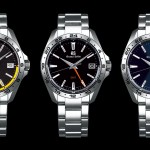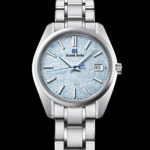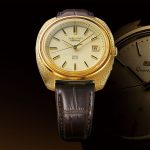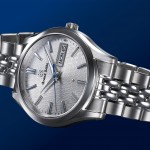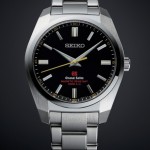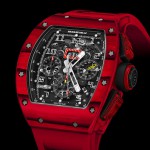EXPLAINED: Seiko 9F Quartz Movements – Definitive Proof That High-End Quartz Exists
A high-end quartz movement would seem to be an oxymoron. But it does exist in the form of the Seiko 9F calibre, a supremely sophisticated quartz chronometer rated to +/- 10 seconds a year. Used primarily in Grand Seiko watches, the 9F is possibly the best quartz movement in the world.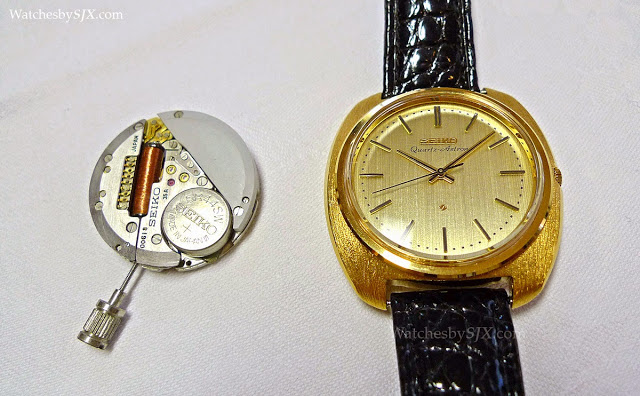
Found solely in Grand Seiko watches and a handful of limited editions (like the recent antimagnetic Grand Seiko), the Seiko 9F family of quartz movements was introduced in 1993, with the goal of the being the best quartz movement possible, not merely in terms of timekeeping, but also in the display of time.
Seiko pioneered the quartz watch in 1969 with the Astron, and in doing so changed the watch industry. Designed by a team led by engineer Kuniharu Natori, who recently retired as Manager of Watch Movement Design and Engineering at Seiko Epson, the calibre 95GS of 1988 was the first quartz movement used in a Grand Seiko.
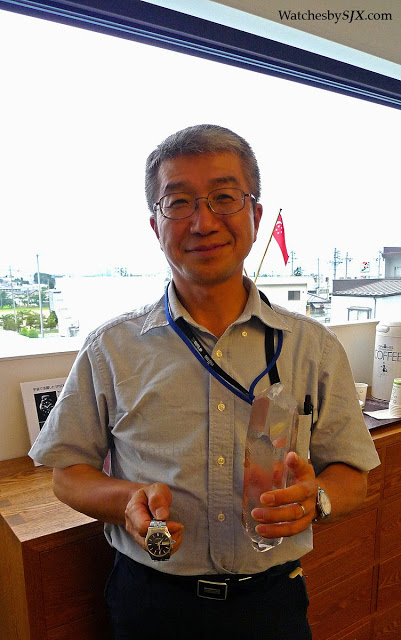 |
| Kuniharu Natori, who led the team that developed the 9F quartz movement, holding his Grand Seiko and a raw quartz crystal |
Quartz, but hand-finished
Five years later the same team presented the 9F quartz calibre, which built on the developments of the 95GS. Even though the 9F is now 20 years old, it still remains one of the most refined quartz movements anywhere, not only in terms of finishing and craftsmanship – it is hand decorated and assembled just like a mechanical movement – but in terms of construction.
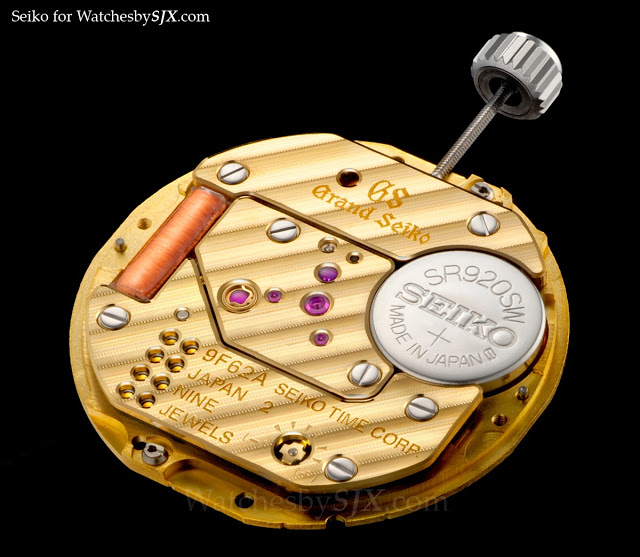 |
| Grand Seiko cal. 9F62 |
With a maximum deviation of +/- 10 seconds a year – the typical mechanical watches manages that in a day – the 9F is extraordinarily accurate. And that performance applies to the mere entry level 9F movements. Specially regulated 9F movements used in some limited edition Grand Seiko models, distinguished by a five-pointed star on the dial, are rated to +/- 5 seconds a year.
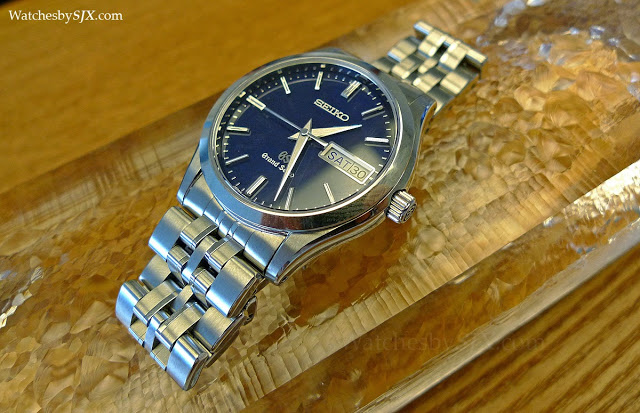 |
| Mr Natori’s Grand Seiko with 9F movement |
A special quartz crystal
That extreme accuracy begins with the quartz crystal that is the heart of a quartz movement, the equivalent of the balance wheel in a mechanical calibre. A quartz movement runs on a basic principle – run a current through a quartz crystal and it will vibrate at a precise frequency that acts as a regulator. Seiko makes its quartz crystals in-house, growing them in massive autoclaves that are some four stories high.
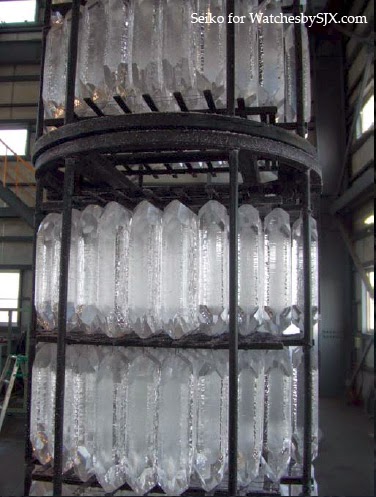 |
| Quartz crystals fresh out of the autoclave |
Over a period of two to six months, the seed crystals, which are long and flat, grow inside the autoclave, at 360 ℃ and under pressure of 1100 to 1700 kg/cm2, eventually growing into chunky blocks which weight several pounds. Each of these quartz crystal is then checked by hand for any imperfections.
After the crystals are machined into necessary size for a quartz oscillator, a 90-day test begins. Each quartz crystal oscillator is tested individually, mainly to ascertain the regularity of its frequency. That’s because quartz oscillators vibrate at extremely high frequencies, that frequency may change every so slightly with temperature and time. The best performing oscillators are then selected for use in 9F movements.
.jpg) |
| The Astron of 1969 on a modern quartz crystal |
Each quartz oscillator is then paired with an integrated circuit specially programmed for that particular oscillator’s frequency and behaviour, to ensure the resulting 9F movement keeps the best possible time.
Consequently, the time display mechanism of the 9F was designed to be up to the task of indicating such accurate time. Several features were designed into the 9F movement to this end. One is the backlash auto-adjust mechanism, essentially a tiny spring linked to the second wheel to minimise backlash and play between the hands.
.jpg) |
| Backlash auto-adjust mechanism |
This is especially important for quartz watches due to the ticking motion of the seconds hand; in conventional quartz watches the seconds hand bounces around the seconds marker as it moves forward second by second, resulting in an imprecise time display. In contrast, the seconds hand of a 9F movement moves in a precise and controlled manner.
And not only are the hands precise, but also much more substantial – thicker and wide – than on ordinary quartz watches. Made possible by a twin-impulse motor, the hands are identical to those on a mechanical Grand Seiko. Normal quartz watches with single-impulse motors have insufficient torque to move such heavy hands.
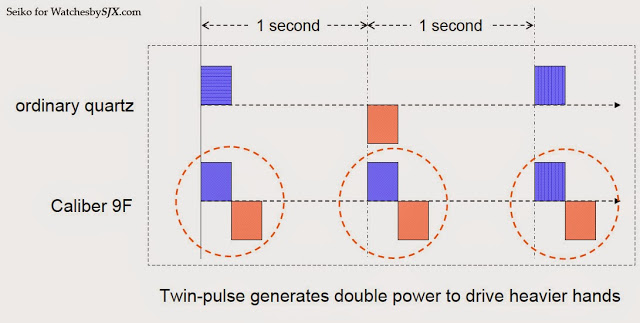 |
| The 9F movement delivers two impulses per second |
In addition, spacers are mounted for both the minute and hour hand pinions to ensure that neither interferes with the motion of the other. All of the three hands on the watch are on genuinely independent axes.
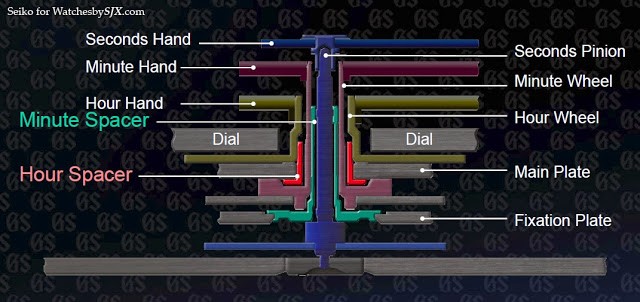 |
| Cross-sectional view of the hands and dial |
Precision of display extends to the date, which is instantaneous. Both the day and date (some models have only a date) jump simultaneously at midnight, completing the jump within 1/2000th of a second. This is thanks to simple, four part date mechanism with a long lever that causes the date disc to jump.
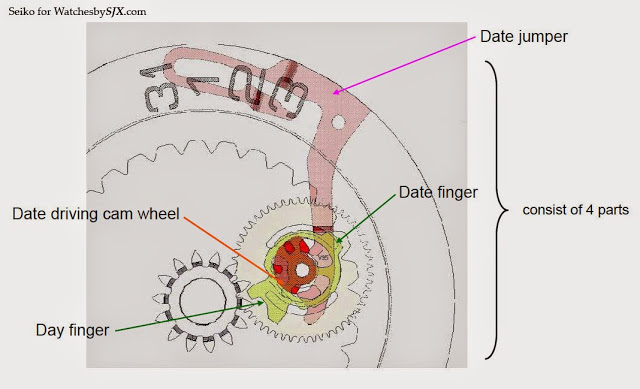 |
| The date mechanism |
Made to last forever And then there is the movement construction, entirely conceived with longevity in mind – which runs contrary to the prevailing opinion that a quartz watch is essentially disposable.
All the vital parts of the movement are sealed in dust-proof enclosures. This is important since quartz watches are opened up regularly for battery replacement, and especially relevant for the central enclosure which houses the gear train, explaining the visible jewels. This not only keep the gear train clean, but also helps keep it running well by preventing lubricants from migrating elsewhere.
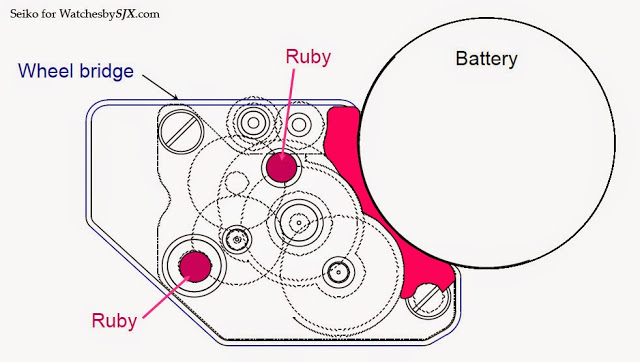 |
| Sealed enclosure for gear train |
The attention to detail extends to the electromagnetic coil of the motor as well. The coil block is sealed, so as to prevent damage to the copper wires – this is a common occurence during battery replacement.
Additionally, the copper wires of the coil are wound in a regular manner, while in a typical coil is is almost random.
.jpg)
All 9F movements are hand-assembled at Seiko Epson in Shiojiri, not far from Nagano, with the same attention to detail as for a mechanical movement. Though it is quartz, the 9F calibre arguably contains more ingenuity and craftsmanship than mechanical movements in the same price segment.
Back to top.
